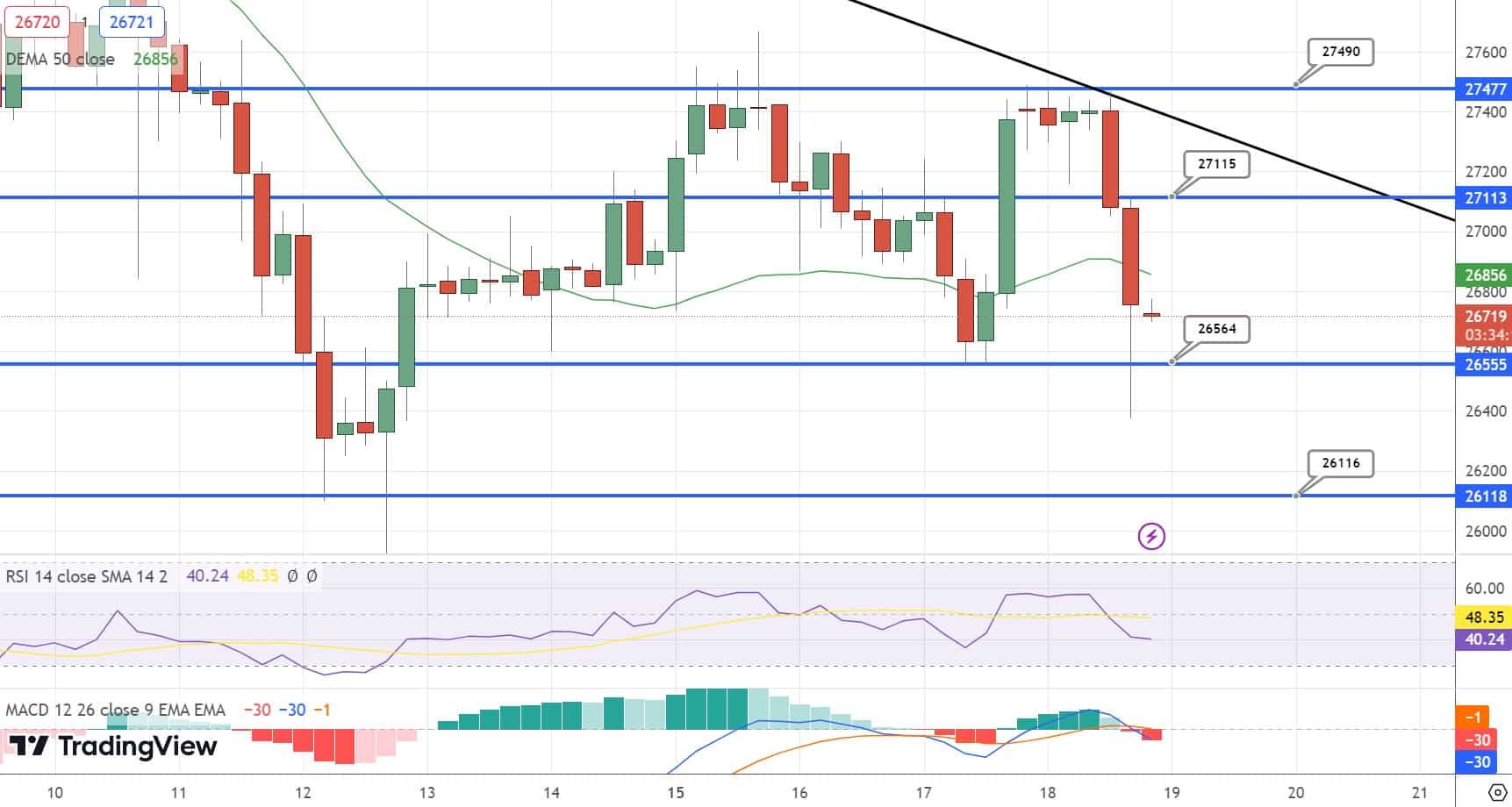
In the volatile world of cryptocurrency, predicting the price movements of Bitcoin, the pioneering digital currency, has been a subject of great interest and speculation. Various metrics and indicators have emerged to gauge the market sentiment and potential price trends.
One such metric, the Binary Cumulative Distribution Delta (CDD), has recently gained attention for its ability to provide insights into the behavior of Bitcoin whales, the large holders of the cryptocurrency.
This Bitcoin price prediction explores the significance of the Binary CDD metric and its indication that Bitcoin whales are holding firm, potentially influencing the future trajectory of Bitcoin’s price.
Bitcoin Price
Bitcoin (BTC), the leading cryptocurrency, has failed to halt it’s declining streak and is still experiencing a period of uncertainty as its price hovers below the $27,000 mark.
This can be attributed to several factors impacting Bitcoin’s price, such as ongoing discussions surrounding the debt ceiling, regulatory concerns, and the influence of the strength of the US dollar.
Bitcoin price retests key support as Fed rate hike fears steal $27K #Bitcoin #BTCprice https://t.co/uUvW6U9O7l pic.twitter.com/OGzJNL3y7V
— bit.trail (@roccodallas) May 19, 2023
Bitcoin’s price has undergone a reversal, declining from its recent peak of $27,400 to around $26,700. This decline can be attributed to ongoing concerns among investors regarding debt ceiling discussions in Washington, DC, as well as regulatory developments.
Over the past three days, Bitcoin has witnessed a continuous decline, resulting in an 8 percent decrease in its value thus far this month.
Market Impact of Debt Ceiling Talks
The ongoing debt ceiling negotiations in the United States have been injecting a sense of uncertainty into the cryptocurrency market. This can be witnessed by the bearish bias of BTC. Bitcoin’s relative instability over the past 24 hours suggests that investors are closely observing these discussions.
Biden's team reports 'progress' in US debt ceiling talks https://t.co/fUbuInHsz0 pic.twitter.com/8NggXHQvXM
— Reuters (@Reuters) May 19, 2023
Hence, the outcome of the negotiations has the potential to influence Bitcoin’s demand, possibly sparking increased interest if the US defaults on its debt. However, there is also a risk of liquidity being affected if the US Treasury runs out of funds.
US Dollar Strength & Cryptocurrency Market:
Another factor that has been affecting the cryptocurrency market is the increasing strength of the US dollar, which has exerted pressure on the cryptocurrency market, creating a challenging environment for digital currencies.
If you're looking for a catalyst to sell stocks for a summer correction, I think US Dollar strength would be that. How strong can the Dollar get after this massive pullback? That will likely tell you how much pressure to expect in stocks imo pic.twitter.com/H2YCRJ8NpV
— J.C. Parets (@allstarcharts) May 18, 2023
Recent statements from Federal Reserve officials hinting at a more aggressive monetary policy stance and the anticipation of higher interest rates have contributed to the dollar’s increased strength.
This situation will potentially impact the demand for cryptocurrencies like Bitcoin, as a stronger dollar typically correlates with a decline in crypto prices.
Thus, Investors are closely monitoring the ongoing debt ceiling talks, recognizing that a potential default could harm asset markets significantly and undermine confidence in the US economy.
Investor Sentiment and Economic Outlook
Investor sentiment regarding the current state of the economy remains pessimistic, with major banks foreseeing a pronounced recession in 2023. The ongoing correlation between cryptocurrency prices and traditional markets, such as the Dow and S&P 500, continues to persist.
NIFTY Importance:
The Nifty 50 reflects investor sentiment and provides insights into the market outlook. It is closely tied to India's economic growth, as its constituents are leading companies across sectors. #Nifty #nifty50 #NiftyBank #optionbuying #b4tt— Abhishek Sharma (@CFOZUCOL) May 19, 2023
In light of the uncertainties surrounding the debt ceiling talks, the upcoming meeting between President Joe Biden and Congressional leaders is important. It is crucial for investors to closely monitor these developments, as they can impact Bitcoin’s demand and shape the overall sentiment in the market.
BTC Options Expiry and Mining Difficulty Surge: Implications for Bitcoin
On the flip side, the upcoming BTC options expiry is crucial for Bitcoin’s price, especially given the concerns about regulations and the US debt ceiling. In this uncertain environment, bearish traders in the Bitcoin market may take advantage of the situation. However, the outcome of the expiry will determine how Bitcoin performs in the short term and could impact its price.
$BTC Options Expiry
Today, over 29,000 #BTC options will expire, worth $780 million…
The put/call ratio is 0.81 (slightly bullish), with a max pain point of $27.5k‼️
Coupled with the FED speech in ~6 hours, #Bitcoin is likely to see major volatility, get ready! pic.twitter.com/VrUq4bCoon
— Crypto Santa (@Blockchainsanta) May 19, 2023
On the other hand, there is positive news for Bitcoin’s network. The mining difficulty level has skyrocketed to a record high, accompanied by a surge in the hash rate, reaching 350 TH/s.
This development signifies a strengthening of security and resilience within the Bitcoin network. With more miners contributing their computational power to validate transactions, the decentralized nature of the blockchain is reinforced.
Therefore, the impact of these developments is dual. The BTC options expiry can create short-term price fluctuations and market volatility. Investors need to monitor the outcome closely.
Simultaneously, the surge in mining difficulty and hash rate reflects the robustness of the Bitcoin network, enhancing its security and decentralization.
Bitcoin’s Uncertainty & Low Trading Activity Indicate Price Impact Potential
According to Glassnode’s data, the amount of Bitcoin being actively traded in 2023 is relatively low compared to the previous bullish market. This means that people are holding onto their Bitcoins instead of selling or buying.
The current level of Binary #Bitcoin Coin Day Destruction remains heavily muted when compared to the sustained elevation in destruction witnessed across the 2021 primary Bull Market.
This suggests mature coins are remaining largely dormant relative to their long standing… pic.twitter.com/h1uevHNvn7
— glassnode (@glassnode) May 17, 2023
Traders are uncertain about Bitcoin’s future, leading to less trading activity and more selling pressure than buying. Momentum indicators show that Bitcoin is oversold, indicating a potential decline in its price.
Thus, the negative Chaikin Money Flow and On-balance volume suggest increased selling pressure. Overall, this news reflects caution among investors and could potentially impact Bitcoin’s price negatively.
What's the Best Crypto to Buy Now?
- B2C Listed the Top Rated Cryptocurrencies for 2023
- Get Early Access to Presales & Private Sales
- KYC Verified & Audited, Public Teams
- Most Voted for Tokens on CoinSniper
- Upcoming Listings on Exchanges, NFT Drops
